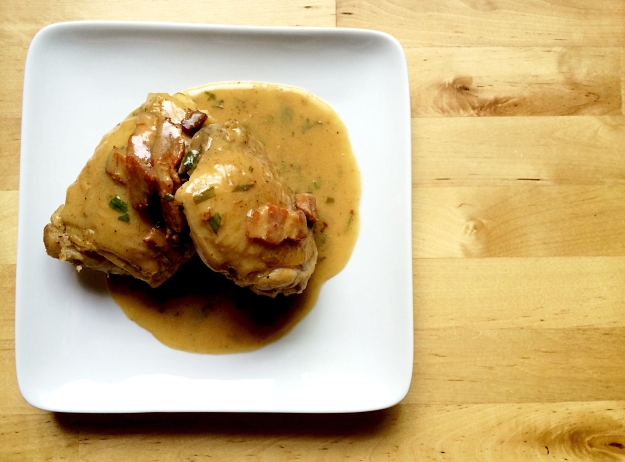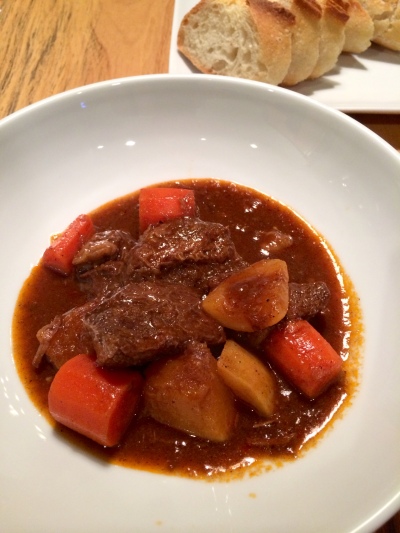 I’ve been trying to get in the habit of using up fresh foods in my kitchen before they go bad. A self-inflicted Iron Chef challenge. “Allez cuisine!” I found that it’s been a great way to challenge and expand my culinary skills. Today, my ‘secret’ ingredients were one ripe peach and a stalk of rhubarb. Really not enough fruit to make much of anything. But, luckily, I had a partial bag of frozen organic blueberries leftover from our Saturday morning pancakes too.
I’ve been trying to get in the habit of using up fresh foods in my kitchen before they go bad. A self-inflicted Iron Chef challenge. “Allez cuisine!” I found that it’s been a great way to challenge and expand my culinary skills. Today, my ‘secret’ ingredients were one ripe peach and a stalk of rhubarb. Really not enough fruit to make much of anything. But, luckily, I had a partial bag of frozen organic blueberries leftover from our Saturday morning pancakes too.
Taking inspiration from my friend, new mother and pastry chef, Sarah and a couple of blogs about galettes, I came up with the recipe below. Sarah was sweet enough to give me some pointers (that I noted in my recipe) after I tasted and became enamored with her ginger peach galette. Her pastry was a perfectly flaky, tender crust filled with slightly sweetened, spiced slices of peach with subtle bits of candied ginger interspersed throughout. The ginger and pepper elements in the recipe below are a take on her version as is finishing with the tart with turbinado sugar (aka sugar in the raw) to give it a little spark.
Lining the bottom of the galette with the almond meal mixture was influenced by the Rhubarb Galette recipe at Tasting Table. I liked the idea of bringing a nutty flavor in and keeping the bottom of the galette from getting soggy. I chose to incorporate the ginger in this layer of the pie as well. It’s less sticky to chop candied ginger into a flour/almond meal mixture than by itself.
The crust/pate brisée is an adaptation of several recipes and their techniques. I’ve struggled with making the perfect pie/tart crust for years and am finally coming close to mastering it. The Cook’s Illustrated recipe in the The Science of Good Cooking, The Food Lab’s post about the Science of Pie Dough and having Sarah video Skype with me while I was making this challenging dough, (Sarah directing, “No, not wet enough!”) has helped me come a long way. I doubt that Sarah is available for the masses via video chat, but, I’d highly suggest you check out the other sources. And I’ve convinced Sarah to let me video her techniques soon. I will share her wisdom!
Thankfully, this impromptu galette turned out delicious. Otherwise, this post would’ve been about the galette that might have been. The tart rhubarb was a compliment to the mellow berry flavor of the blueberry and peach. The ginger added a nice spice and the almond meal a subtle nuttiness. I’ll be making it this new recipe again soon. I hope you’ll enjoy it as much as we did.
Crust
8 oz. (1 1/2 cups) flour
4 oz. (8 Tbsp./1 stick) butter
2 Tbsp. vegetable shortening
½ tsp. salt
Equal parts cold water/vodka
1 beaten egg for brushing
Turbinado/Raw sugar
Almond layer
3 Tbsp. almond flour
1 Tbsp. sugar
1 Tbsp. flour
2 Tbsp. candied ginger
Filling
1 cup rhubarb, sliced
1 cup peach, cubed
2 cups blueberry, frozen
3 Tbsp. sugar
1 Tbsp. corn starch
¼ tsp. salt
¼ tsp. cinnamon
A couple cracks of fresh pepper
½ tsp. vanilla extract
1 tsp. Chambord or other raspberry liquor
1 tsp. lemon juice
Preparing the crust
Plan this part ahead as the dough will at minimum need to rest in the refrigerator for 1 hour. Preferably 2 or more for a tender crust. Sarah rests hers overnight for optimal tenderness. Also, all your fats and liquids should be ice cold. Freeze you butter and shortening as well your vodka. Though the vodka sounds like an odd choice. It’s tasteless and will cook off, but it will not encourage gluten development (like water), so it’s a great way to make the dough more pliable while avoiding the peril of a leathery shell. And the word on the street is work your dough as little as possible for a tender, flaky crust.
- In your food processor, pulse ½ (4 oz./1 cup) of flour and salt together.
- Add cold shortening, cubed butter and pulse for a few seconds until only lentil size pieces of fat remain.
- Add the rest of flour and pulse a couple of times to incorporate.
- Turn dough over into a large bowl.
- Sprinkle 2 Tbsp. of ice-cold water and 2 Tbsp. of cold vodka over mixture and fold in with a spatula. If dough is still dry and crumbly, alternately add water and vodka, 1 Tbsp. at a time, gently folding until dough has just come together. Dough should form into a ball easily, but, not be sticky.
- Shape dough into a round disc, about 1” thick and let rest in fridge for 1-2 hour or overnight.
- Flour your counter generously and turn out cold dough.
- A tip from Sarah for unfrayed edges: with the palm of your hand pound the edges of your dough disc. Forcefully pound then turn dough to a new section and work your way 2 to 3 times around.
- Another Sarah bit of wisdom regarding rolling the dough: roll only in one direction. Going back and forth will overwork your pastry. It’s best to roll gently, turn the dough 1/8 to ¼ turn and repeat until desired thickness and size is achieved. The goal is to gently but quickly roll out dough without too much pressure. This should keep your dough flaky and tender and ensure a rounder shape.
- When dough is approximately a 13” plus round, trim excess to make a nice circle. I used a 13” pizza pan over my dough and trace around it with a knife.
- Check and repair any holes or broken edges so that filling doesn’t leak.
- Place your dough round on a cookie sheet lined with a Silpat or parchment paper. Let rest in fridge while you’re putting together the filling.
Assembling the galette
- Preheat oven to 400 degree with one rack on the bottom and one in the middle. If using a Breville Smart Oven, which I did, use bottom rack and bake on the parchment-lined pizza pan provided with oven.
- On a large cutting board, combine all the ingredients for the almond layer (almond flour, sugar, flour and candied ginger). With a large kitchen knife, chop ginger finely into mixture. Set aside.
- Place blueberries, peach and rhubarb in a large bowl.
- Sprinkle the rest of the filing ingredients (sugar, corn starch, salt, cinnamon, fresh pepper, vanilla extract, Chambord and lemon juice) over the fruit and with a spatula gently fold in, so that mixture is evenly incorporated, being careful not to bruise blueberries.
- Remove crust from fridge. Sprinkle almond mixture evenly on the bottom center of the shell, leaving a 3” edge.
- Top almond layer with fruit mixture, spreading evenly.
- To fold in edges of crust: fold, turn 1/8 of the way, and repeat until a nice pleat is achieved or roughly gather edges in for a more rustic look.
- Generously brush edges with beaten egg, getting wash into folded creases (this will help folds to stay put).
- Sprinkle exposed galette crust with raw sugar.
- Bake at 400 degrees for 15 minutes on the lower shelf of your oven to ensure a crispy bottom.
- Turn oven down to 350, move galette to center rack and bake for an additional 30-45 minutes until crust is golden brown and filling is bubbly.
- If fruit looks dry on top, use a pastry brush to spread liquid part of filling.
- Let galette rest for an hour on baking sheet or gently slide pastry over onto to a cooling rack and cool for a crisper bottom.
- Serve by itself, with fresh whipped cream or ice cream.
 My early childhood was spent in Grenoble, France, where dinner at my parents’ friends house happened weekly. Our friend Marie-France’s specialty was Poulet a l’Estragon (Tarragon Chicken): a whole cut up chicken, braised in a mixture of bacon, crème fraiche, white wine and tarragon. It was a childhood favorite of mine. Who can resist creamy, bacon-ey chicken?
My early childhood was spent in Grenoble, France, where dinner at my parents’ friends house happened weekly. Our friend Marie-France’s specialty was Poulet a l’Estragon (Tarragon Chicken): a whole cut up chicken, braised in a mixture of bacon, crème fraiche, white wine and tarragon. It was a childhood favorite of mine. Who can resist creamy, bacon-ey chicken?



